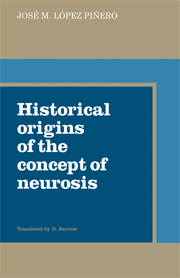Introduction
Published online by Cambridge University Press: 06 August 2010
Summary
Although the history of the concept of neurosis during the twentieth century can be said to be a direct continuation of the views of Charcot and Freud, it has created severe difficulties amongst historians; this problematic character partially results from the fact that it has been used as a battle ground by schools of thought such as the scientific-natural method, psychoanalysis and psychosomatic pathology. Over the years this has given rise to numerous attempts at reformulating the concept of neurosis, criticising its foundations and even eliminating it altogether.
Most authors agree on the usefulness of analysing the concept historically. In a meeting held in 1925, dedicated to a ‘Revision of the Problem of the Neurosis’, Oswald Bumke, a representative of the reaction of German academic psychiatry against psychoanalysis, stated:
The first step in this revision is to obtain a clear view of what the term neurosis has meant in the past and means nowadays. As none of us would wish to resolve research questions by a majority vote, an attempt should be made to extract, from the historical evolution of the concept, ideas as to what direction the doctrine of neurosis might follow in the future.
Unfortunately Bumke did not undertake nor encourage anyone else to do any historical research. He simply iterated few commonplaces about the evolution of the concept and used them to support his personal views.
- Type
- Chapter
- Information
- Historical Origins of the Concept of Neurosis , pp. ix - xiiPublisher: Cambridge University PressPrint publication year: 1983

